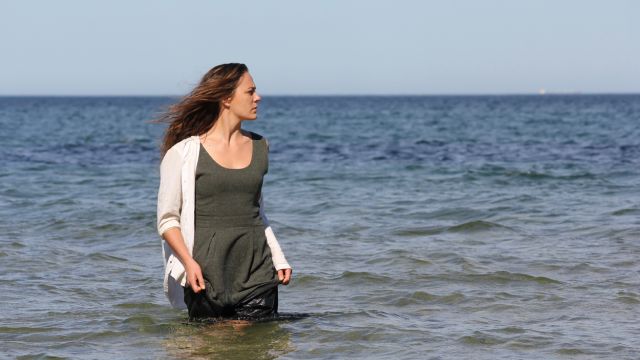Ellida
‘The lure of the sea. Longing for the sea.’ So wrote Henrik Ibsen after two months on Norway’s Atlantic coast. ‘’Compulsion to return to it… The sea… has its own willpower… [it] can hypnotise.’ These reflections, a likely inspiration for his The Lady from the Sea, are central to this late work (1888) of ‘freedom’, obsession and inexplicable love.
The eponymous Ellida (Annie Thorald), married to widower Dr Wangel (Jason Kavanagh) and stepmother to Bollette (Meg Spencer) and her teenage sister Hilde (Esther Miles), is possessed by her love for a sailor, The Stranger (Frank Handrum), whom she knew only for days and yet feels bound to him – as she is drawn to the sea… Meanwhile, the girls’ former teacher Arnholm (Gabriel Partington) arrives hoping to win the hand of Bollette, and a would-be young sculptor Lynstrand (Martin Quinn) dreams of going south, but hopes Bollette with ‘think of him’. Such is a reductive summary of the play’s set-up.
Typically, director Laurence Strangio sets himself a challenge. He compresses Ibsen’s five acts into one hour and fifty minutes and it plays out on a single set that must stand in for multiple locations. I hope I won’t seem flippant, however, if I say that, in addition, The Lady from the Sea is not one of Ibsen’s more successful plays although it has been adapted for film and television, and gets regular theatrical revivals. Its combination of almost Chekhovian naturalism (and humour) and poetic symbolism feels awkward (despite the new translation), so that the ‘happy ending’ (rare in any case for Ibsen) is sudden and psychologically unconvincing.
Surrounded by more naturalistic characters, Ellida – the poetic or even symbolic character here - can seem an annoying solipsistic neurotic – with all due respect to Ms Thorald who does all she can to set up the ending. If Ellida is in the grip of an obsession – an obsession that has made her marriage no more than a convenient deal and cut her off from her stepdaughters and her husband – she relinguishes it in seconds. The parallel and naturalistic sub-plots of Arnholm/Bollete and Bollette/Lynstrand possibly get more playing time than they merit, although Ms Spencer and Ms Myles, as the sisters, give very acute portrayals and are very entertaining in fleshing out rather shadowy figures.
Mr Quinn’s Lynstrand is freighted with symbolism, but as a character beside, say, the sisters, he is ludricrous. Thus Mr Quinn, presumably with Mr Strangio’s approval, camps it up and pushes Lynstrand into caricature; he gets a lot of laughs, but it is as if he’s in some other play. Mr Kavanagh meanwhile struggles too to give some vitality to stodgy, prosaic Dr Wangel – a character who only achieves some stature in the final act. The challenge of making all this ‘work’ as a coherent whole is huge.
When the much-anticipated Stranger finally appears, Mr Handrum is suitably charismatic: he looks romantic and as if he strides the oceans, but why produce a revolver that is not used? Ask Ibsen, I suppose. But in the key exchanges between the Stranger and Ellida, the dialogue reverts to Norwegian. I can only think the intention here is to create their world, their heightened connection and apprehension of each other. The Stranger is not just a man, he is, also, for Ibsen, a symbol of the Sea, of the lure of freedom. The relationship is outside the realm of the rational, of obligation and responsibility: it excludes mere mortals. But of course, it excludes the audience too, and we are left wondering what they are saying and why we can’t hear these vitally important words.
Mr Strangio makes other interesting decisions. The choric figure of Ballested (Dave Evans), a local artist, weighs in with his painting of a dead mermaid, but he also sings some songs that comment on the action. While his incidental music per se, played on his accordion, is haunting and effective, the songs are not just naff but, I’m afraid, redundant.
Never one to leave the Courthouse playing space untouched, here Mr Strangio and his designer Mattea Davies have constructed a series of stepped platforms that rise almost to the high ceiling – which means that the audience looks up to the actors throughout and the actors, meanwhile, overlook the fjord of the play. This is inspired, as is the way Mr Strangio positions his cast on these platforms as the story proceeds, but unfortunately these platforms are draped in strips of fabric of varying shades of green. Was this due to budget? I just couldn’t get past it: it simply looks scrappy and, dare I say, amateur. Better to have left the platforms black or some neutral colour and relied more on Richard Vabre’s excellent lighting.
It pains me to make these criticisms since I admire Mr Strangio’s nerve, originality and constantly interesting – or indeed fascinating – choices of subject, but Ellida is a mixed bag – as is Ibsen’s play.
Michael Brindley
Subscribe to our E-Newsletter, buy our latest print edition or find a Performing Arts book at Book Nook.

